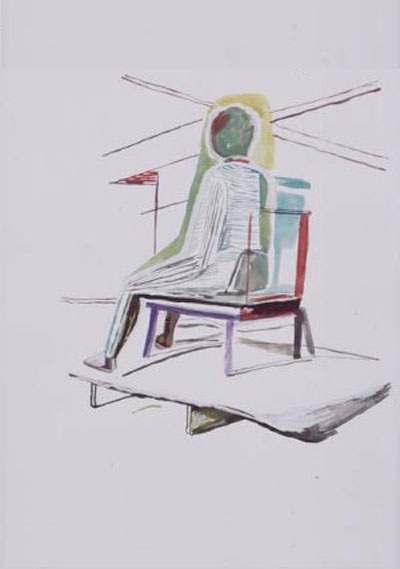 Neal Tait The burnished ramp White Cube is pleased to present a new group of paintings by British artist Neal Tait. Tait is a painter whose subjects are always contingent and this exhibition brings together a series of new works that demonstrate his concerns with painting as an exploratory process, whereby meaning can be suggested through the handling of paint itself. In these paintings large areas of canvas remain blank, creating the feeling of open-ended, expanded works which seem to suggest many different narratives; transparent washes and thin skeins of paint describing simple, informal structures. These works seem to display an extreme version of figuration, which, through their flat, reduced palette, push the limits of representation. In 2002, Tait spent several months living and working in Rome, and the background of architectural fantasy, as well as baroque and faded beauty informs much of this new work, providing the filter for a series of paintings that suggest a subdued history of distress, violence and absolution. They allude to romantic narratives that carry with them their own inherent destruction. Tait describes this position as dualistic in the sense that sometimes his works offer-up no easy conclusions but instead seem to take on a charge quite independently of his own painterly ability. In one large canvas, for example, vaporous clouds of silver and grey reveal etched flowers partially rubbed away: an antique mirror, defiled by hasty, scratched graffitti. In another, two figures emerge out of a stain of orange and red, floating amid the untouched white of the raw canvas. In another, a simplified dovecote is surrounded at its base by a series of protean almost human shapes, twisting and arching as if absorbed in some ritualistic, totemic dance. These paintings are solemn, entropic, shadowy images that reveal themselves once the picture is finished, emerging out of a kind of collapse, at an unpredictable moment of resolution that can often be abrupt and inconclusive. Deliberately open-ended, they activate a viewing process that encourages timely contemplation. They appear mute, in the sense that their syntax is purely internal and hermetic and non-referential to a readable or familiar world. Instead, they seem to offer-up the visual evidence of a trail of thought, their architectural elements seeming more akin to something mental, psychologically driven in its intent. A figure in one painting, for instance, is depicted abstractly through a series of elongated lines that seem to extend into the supporting chair and the background of the painting itself. In another, the branches of a tree become a fantasy ladder with an unknown destination. Animate and inanimate objects morph into each other through a deliberately disruptive use of scale: a body lays prone, floating behind a lampshade, wrapping around its base in a band of mustard yellow. Tait often works from various types of source material - an image in a magazine, a sketch from the imagination, or as is most often the case, a photograph. He often reworks paintings over a length of time, adding and subtracting elements according to the internal dynamic of the painting, which is sometimes bold and at other times obscure. In the past, Tait has explored a series of given, irreducible structures such as a group of suburban houses, simplified to their most basic elements - four walls, a window and a roof. In these new paintings, there is a similar distillation at work, where a thought process has been reduced to an ineffable subject, darkly emotional and suggestive of a burgeoning psychological drama. June 5 - July 5, 2003 Hours: Tue-Sat 10 am - 6 pm White Cube 48 Hoxton Square GB-London N1 6PB Telefon +44 020 7930 53 73 Fax +44 020 7749 74 80 www.whitecube.com |